Quarter-five-spot example
Immiscible IntroductionThe quarter-five-spot is a standard test problem that simulates 1/4 of the five spot well pattern by assuming axial symmetry. The problem contains an injector in one corner and the producer in the opposing corner, with a significant volume of fluids injected into the domain.
using JutulDarcy, Jutul, HYPRE, Statistics
nx = 50;Setup
We define a function that, for a given porosity field, computes a solution with an estimated permeability field. For assumptions and derivation of the specific form of the Kozeny-Carman relation used in this example, see Lie, Knut-Andreas. An introduction to reservoir simulation using MATLAB/GNU Octave: User guide for the MATLAB Reservoir Simulation Toolbox (MRST). Cambridge University Press, 2019, Section 2.5.2
function perm_kozeny_carman(Φ)
return ((Φ^3)*(1e-5)^2)/(0.81*72*(1-Φ)^2);
end
function simulate_qfs(porosity = 0.3)
Dx = 1000.0
Dz = 10.0
bar, kg, meter, day = si_units(:bar, :kilogram, :meter, :day)
mesh = CartesianMesh((nx, nx, 1), (Dx, Dx, Dz))
K = perm_kozeny_carman.(porosity)
domain = reservoir_domain(mesh, permeability = K, porosity = porosity)
Inj = setup_vertical_well(domain, 1, 1, name = :Injector);
Prod = setup_vertical_well(domain, nx, nx, name = :Producer);
phases = (LiquidPhase(), VaporPhase())
rhoLS = 1000.0*kg/meter^3
rhoGS = 700.0*kg/meter^3
rhoS = [rhoLS, rhoGS]
sys = ImmiscibleSystem(phases, reference_densities = rhoS)
model = setup_reservoir_model(domain, sys, wells = [Inj, Prod])
c = [1e-6/bar, 1e-6/bar]
ρ = ConstantCompressibilityDensities(p_ref = 150*bar, density_ref = rhoS, compressibility = c)
kr = BrooksCoreyRelativePermeabilities(sys, [2.0, 2.0])
replace_variables!(model, PhaseMassDensities = ρ, RelativePermeabilities = kr);
state0 = setup_reservoir_state(model, Pressure = 150*bar, Saturations = [1.0, 0.0])
dt = repeat([30.0]*day, 12*10)
dt = vcat([0.1, 1.0, 10.0], dt)
inj_rate = Dx*Dx*Dz*0.3/sum(dt) # 1 PVI if average porosity is 0.3
rate_target = TotalRateTarget(inj_rate)
I_ctrl = InjectorControl(rate_target, [0.0, 1.0], density = rhoGS)
bhp_target = BottomHolePressureTarget(50*bar)
P_ctrl = ProducerControl(bhp_target)
controls = Dict()
controls[:Injector] = I_ctrl
controls[:Producer] = P_ctrl
forces = setup_reservoir_forces(model, control = controls)
return simulate_reservoir(state0, model, dt, forces = forces, info_level = -1)
endsimulate_qfs (generic function with 2 methods)Simulate base case
This will give the solution with uniform porosity of 0.3.
ws, states, report_time = simulate_qfs();Plot the solution of the base case
We observe a radial flow pattern initially, before coning occurs near the producer well once the fluid has reached the opposite corner. The uniform permeability and porosity gives axial symmetry at
using GLMakie
to_2d(x) = reshape(vec(x), nx, nx)
get_sat(state) = to_2d(state[:Saturations][2, :])
nt = length(report_time)
fig = Figure()
h = nothing
ax = Axis(fig[1, 1])
h = contourf!(ax, get_sat(states[nt÷3]))
ax = Axis(fig[1, 2])
h = contourf!(ax, get_sat(states[nt]))
Colorbar(fig[1, end+1], h)
fig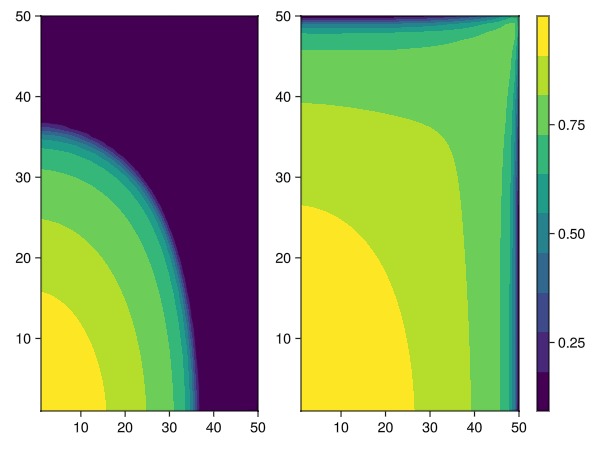
Create 10 realizations
We create a small set of realizations of the same model, with porosity that is uniformly varying between 0.1 and 0.3. The main idea is to get significantly different flow patterns as the porosity and permeability changes, and we will return to more realistic porosity fields later in this example.
function simulate_porosities(porosities)
wellsols = []
s = []
report_step = Int(ceil(0.5*nt))
for poro in porosities
ws_i, states_i, rt = simulate_qfs(poro)
push!(wellsols, ws_i)
push!(s, get_sat(states_i[report_step]))
end
return (wellsols, s)
end
N = 10
porosities_uniform = []
for i in 1:N
push!(porosities_uniform, 0.1 .+ 0.2*rand(Float64, (nx*nx)))
end
wells, saturations = simulate_porosities(porosities_uniform);Plot the gas rate at the producer over the ensemble
using Statistics
function plot_wells(wellsols)
fig = Figure(size = (1000, 600))
ax = Axis(
fig[1, 1],
xlabel = "Time [days]",
ylabel = "Gas rate [m³/s]",
title = "Producer gas rate",
)
t = wellsols[1].time./si_units(:day)
avg_rate = zeros(length(t))
for ws in wellsols
q = abs.(ws[:Producer][:grat])
avg_rate += q
lines!(ax, t, q, color = :grey)
end
avg_rate ./= length(wellsols)
lines!(ax, t, avg_rate, color = :red, linewidth = 3, label = "Mean")
axislegend(ax, position = :lt)
xlims!(ax, [0.5mean(t), t[end]])
fig
end
plot_wells(wells)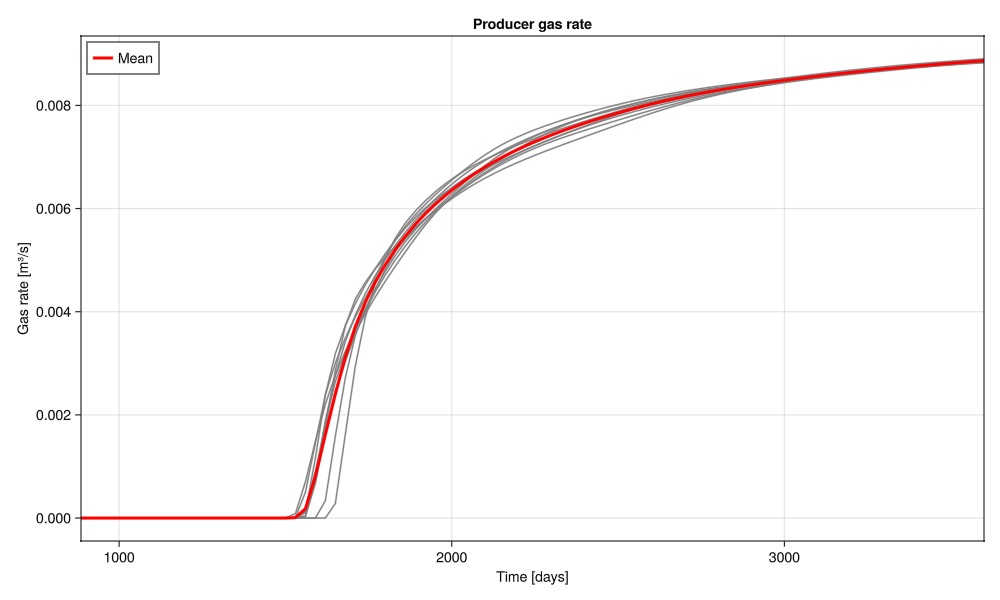
Plot the average saturation over the ensemble
avg = mean(saturations)
fig = Figure()
h = nothing
ax = Axis(fig[1, 1])
h = heatmap!(ax, avg, colorrange = (0.0, 1.0))
fig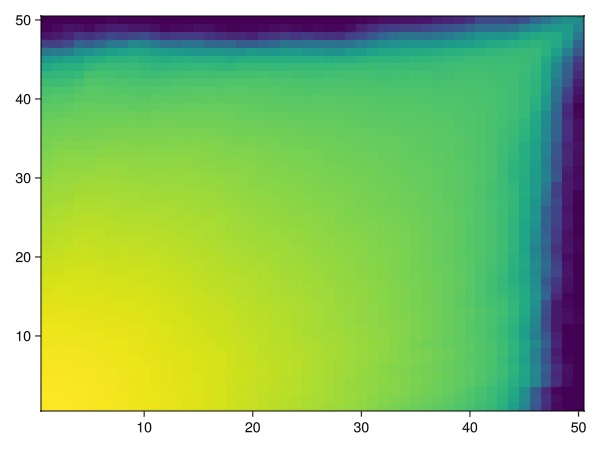
Plot a few realizations of porosity and resulting gas saturation
Note that the porosity fields are uniformly random without any spatial correlation.
function plot_realizations(sat, poro)
fig = Figure(size = (1000, 400))
poro_crange = (0.15, 0.25)
sat_crange = (0.5, 1.0)
h1 = h2 = nothing
n_to_plot = 5
for i in 1:n_to_plot
ax = Axis(fig[1, i], title = "Gas saturation realization $i")
h1 = heatmap!(ax, sat[i], colorrange = sat_crange)
ax_poro = Axis(fig[2, i], title = "Porosity realization $i")
h2 = heatmap!(ax_poro, to_2d(poro[i]), colorrange = poro_crange)
end
Colorbar(fig[1, n_to_plot+1], h1)
Colorbar(fig[2, n_to_plot+1], h2)
return fig
end
plot_realizations(saturations, porosities_uniform)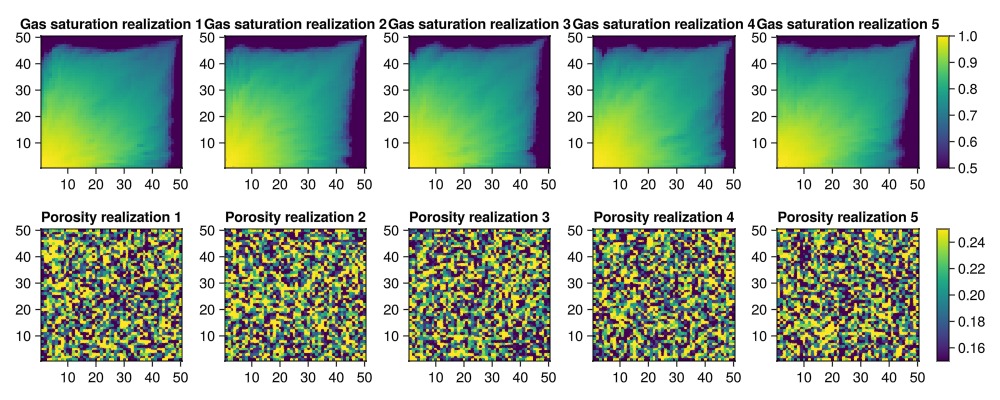
Use GeoStats.jl for more realistic porosity fields
Taking uniformly random samples is not a very realistic way to generate porosity fields. A more realistic approach is to use geostatistical methods from GeoStats.jl.
We here use a Gaussian process with a spherical covariance to generate the porosity fields. The setup is taken from the GeoStats.jl documentation which has more details on the approach.
import GeoStats: CartesianGrid, GaussianProcess, GaussianVariogram, SphericalCovariance, viz!
N = 30
grid = CartesianGrid(nx, nx)
proc = GaussianProcess(SphericalCovariance(range=30.0), 0.0)
real = rand(proc, grid, N)2D Ensemble
domain: 50×50 CartesianGrid
variables: field
N° reals: 30Plot mean and variance of the realizations
m, v = mean(real), var(real)
fig = Figure(size = (800, 400))
axl = Axis(fig[1, 1], title = "Mean")
axr = Axis(fig[1, 2], title = "Variance")
viz!(axl, m.geometry, color = m.field)
viz!(axr, v.geometry, color = v.field)
fig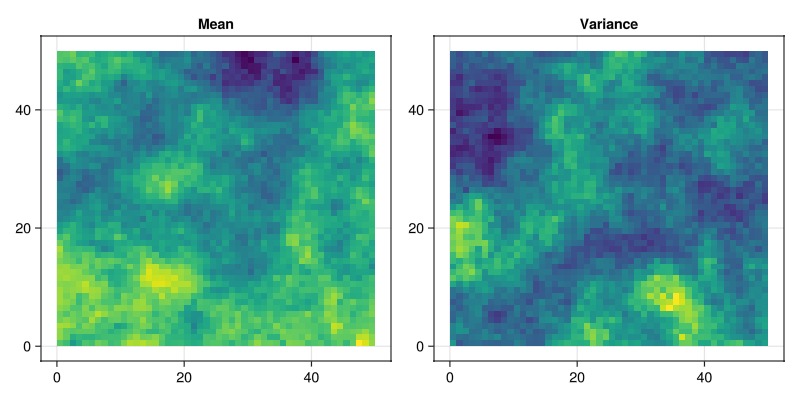
Run simulations with the new porosity fields
We here map the realizations to porosity values between 0.05 and 0.195, and run the simulations. Note that in a more realistic workflow we would condition the process on data instead of taking unconditional realizations.
to_poro(x) = 0.2 + 0.1*clamp(x, -2.0, 2.0)/4.0
porosities_gaussian = map(i -> to_poro.(real[i].field), 1:N)
wells_gaussian, saturations_gaussian = simulate_porosities(porosities_gaussian);Plot the producer rate over the ensemble
plot_wells(wells_gaussian)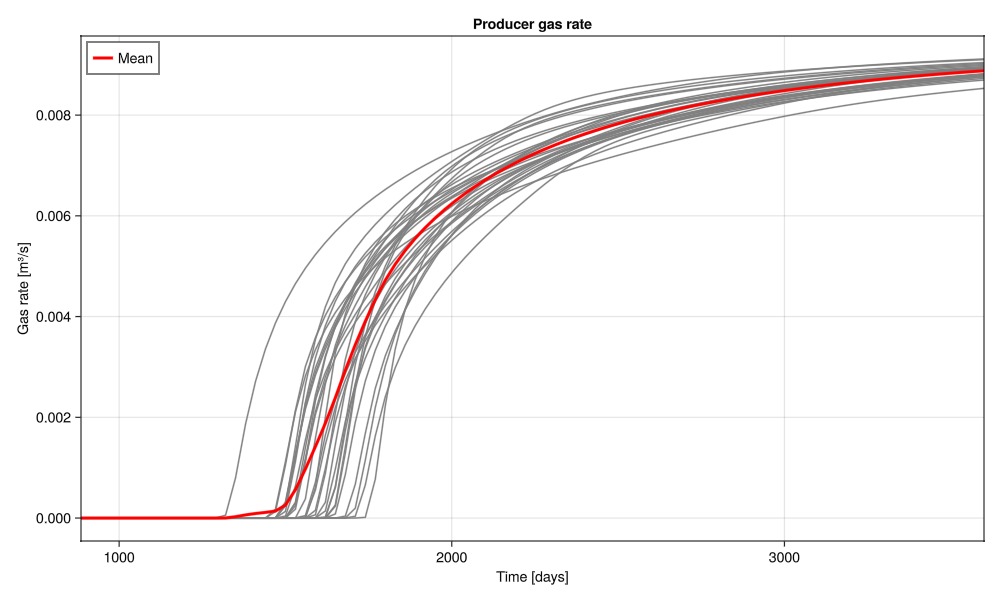
Plot a few realizations for the Gaussian porosity fields
We observe that the porosity fields now have spatial correlation.
plot_realizations(saturations_gaussian, porosities_gaussian)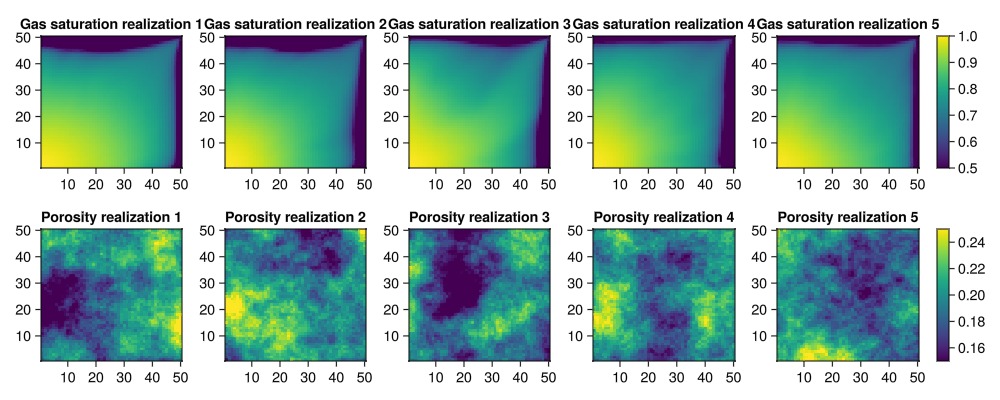
Example on GitHub
If you would like to run this example yourself, it can be downloaded from the JutulDarcy.jl GitHub repository as a script, or as a Jupyter Notebook
This example took 157.314344953 seconds to complete.This page was generated using Literate.jl.